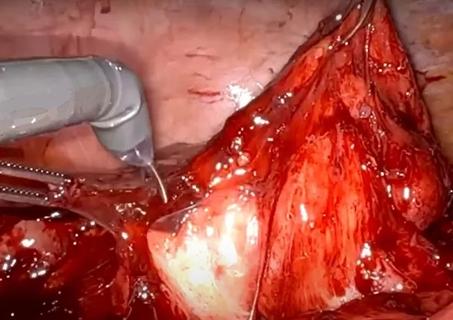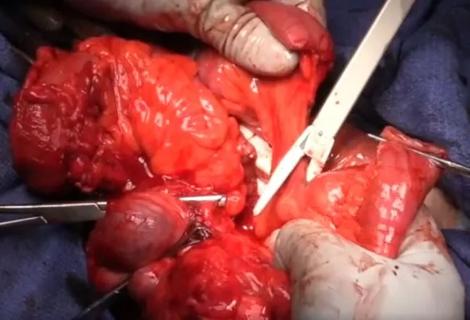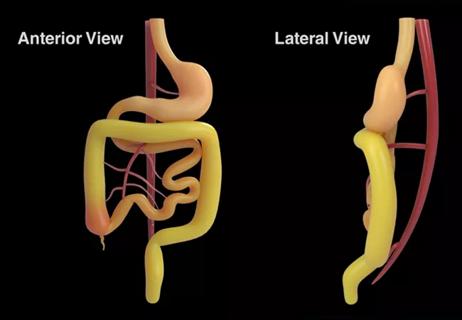Many patients with Crohn’s disease eventually require surgery to resolve fibrotic strictures that develop due to inflammation and repetitive scarring in the small bowel.
Cleveland Clinic is a non-profit academic medical center. Advertising on our site helps support our mission. We do not endorse non-Cleveland Clinic products or services. Policy
Larger strictures can be identified using preoperative CT or MRI enterography or by intraoperative visual inspection of the bowel. However, more subtle intraluminal strictures can be easy to miss with observation alone, which could necessitate repeat strictureplasty surgery if symptoms of obstruction persist.
In a new video and report in Diseases of the Colon & Rectum, Cleveland Clinic Inflammatory Bowel Disease Surgery Section Chief Stefan Holubar, MD, MS shares a simple, effective stricture assessment technique using intraoperative calibration spheres.
A sterile, stainless steel sphere is introduced to the lumen during surgery and is advanced through the small bowel using gentle pressure. If the sphere encounters a stricture and cannot pass, the surgeon performs a strictureplasty to widen the bowel segment. “It’s a simple technique, quick and easy,” Dr. Holubar says. “This is just one more tool in the toolbox of bowel-preserving surgery that we can apply to our patients with small intestinal Crohn’s disease.”
The spheres are used in jewelry-making and are sold online in sets of various diameters for as little as $10. They can be sterilized in an autoclave.
Dr. Holubar and colleagues have used the technique for several years. He says he decided to share his experience because he lately has treated a higher volume of patients for whom the stricture-detection method is applicable.
Other techniques for identifying strictures in the bowel include inserting a Foley catheter or Baker tube with an inflatable balloon via enterotomy. But, he says, those techniques are cumbersome and can only be used to access a portion of the small bowel.
The calibration sphere technique is appropriate for Crohn’s disease patients with diffuse jejunoileitis, a subgroup characterized by multiple strictures in the small bowel. While some patients may only have three or four strictures, a few develop between 10 and 20. “If they have more than several strictures, we usually try to interrogate the bowel with the spheres,” Dr. Holubar says.
Strictures can be opened with Heineke-Mikulicz strictureplasty, or with less common techniques including Finney or Michelassi strictureplasty, Dr. Holubar says. In some cases, he says, if the sphere can be manipulated through a stricture using gentle pressure, surgery may not be necessary.
“It’s somewhat controversial, because some people advocate that all strictures should be addressed at the time of surgery,” he acknowledges. “However, sometimes we find strictures that are subclinical. There’s scarring, but the lumen is still open. Any hole we make in the intestine has the potential for complication or a leak, so we want to avoid any invasive steps that aren’t necessary.”
With recent advances in anti-inflammatory and biologic therapies, it’s possible that these subclinical strictures could be managed with a new generation of medications, he adds.
Additionally, the spheres themselves may serve as a form of endoluminal dilation in some cases. Currently, the main alternative to strictureplasty is endoscopic balloon dilation. However, this technique can only reach one or two feet into the small bowel.
“In my practice, I have found that if the sphere can pass with gentle pressure, that can act in a way that’s analogous to endoscopic balloon dilation,” Dr. Holubar says. “But that’s an advanced technique, and you have to be careful with it.”
In fact, surgeons using intraoperative calibration spheres should be aware that using too much force can damage the small intestine.
“If it pops through a stricture with gentle pressure, that’s fine,” Dr. Holubar says. “But if you try to force it through, you risk disrupting the mucosal lining or even causing a full-thickness defect that could lead to a leak. We take quite a bit of care to make sure we’re not using too much pressure.”
Feature image caption: Surgeons insert a calibration sphere into the small bowel and prepare to advance it for stricture identification.
Image credit: From Duraes LC, Lee CHA, Holubar SD. Use of Intraoperative Calibration Spheres for Endoluminal Stricture Assessment to Facilitate Heineke-Mikulicz Strictureplasty in Diffuse Stricturing Crohn’s Jejunoileitis. Dis Colon Rectum. 2022 Jul 1;65(7):e741-e742. Epub 2022 Mar 23. Copyright © 2022, The American Society of Colon & Rectal Surgeons, Inc. Used with permission of Wolters Kluwer Health Inc.

Lifesaving procedure, continued pregnancy and healthy delivery highlight program’s advancement

Robot-assisted technique provides an alternative to open surgery in a complex case

Cleveland Clinic team blends extended mesenteric excision and Kono-S anastomosis

Continued pregnancy and delivery are only the second successful outcome worldwide

FETO and twin-twin transfusion syndrome treatments are next

New procedure eliminates volvulus risk

Measuring outcomes becomes more granular with surgeon-entered data

Transitional surgical clinic includes pediatric and adult specialists